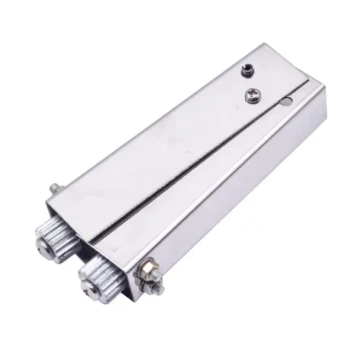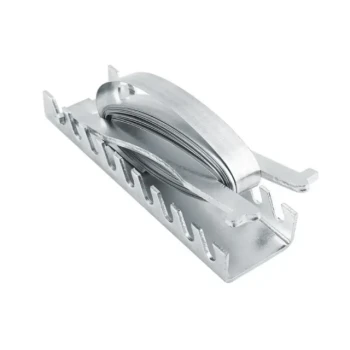The optimal time to treat a nucleus colony (nuc) for varroa mites is during a naturally occurring broodless period. For a nuc made without a queen (a walk-away split), this window typically occurs for one or two days around 30 days after its creation. Treating during this brief period allows for a highly effective "knockdown" of the mite population.
The question is not just when to treat, but how your chosen treatment method aligns with the nuc's development. Your strategy depends on whether you plan to leverage a natural brood break for a single, high-impact treatment or provide continuous control as the colony grows.

The "Golden Window": Targeting the Broodless Period
The most effective mite treatments work on phoretic mites—those physically attached to adult bees. When a colony has sealed brood, a majority of mites are hidden under the wax cappings, protected from treatment. Creating a nuc that must raise its own queen provides a natural, predictable window where no sealed brood exists.
Why a Brood Break Matters
Varroa mites reproduce exclusively within sealed brood cells. By treating when there is no brood, you ensure that nearly 100% of the mites are exposed and vulnerable.
This allows for a single, well-timed treatment to reset the nuc's mite load to nearly zero, giving the new colony a clean start.
Calculating the Treatment Window
This timeline applies to a nuc made by moving frames of eggs and nurse bees without a queen, forcing the bees to raise their own.
- Day 0: The nuc is created. The bees begin raising a new queen from the available eggs.
- Day 19-21: The last of the original capped brood from the parent hive will have emerged.
- Day 28-30: The new queen will have mated and begun laying, but her first eggs will not yet be sealed.
This creates a brief broodless window around day 30, which is the ideal time for a one-time, high-efficacy treatment.
Recommended Treatments for This Window
Because you are targeting only phoretic mites, "flash" treatments that work quickly are ideal.
Oxalic Acid (OA) is the standard for this application. It can be applied via vaporization (OAV) or a dribble method. It is highly effective against phoretic mites but has zero effect on mites under cappings, making it perfect for a broodless period.
HopGuard is another contact-based miticide that can be used effectively during this window, as it works on the mites present on the adult bees.
An Alternative Strategy: Continuous Treatment
An entirely different approach is to use a slow-release miticide strip shortly after the nuc is created. This method does not depend on a broodless period for its effectiveness.
How Continuous Miticides Work
Strips like Apivar (active ingredient: amitraz) are placed in the hive and slowly release a miticide over several weeks.
As bees come into contact with the strip, they pick up the active ingredient and spread it throughout the colony. This method kills mites as they emerge from cells with newly hatched bees, providing long-term control over multiple brood cycles.
When to Apply
With this strategy, the strip is added shortly after the nuc is made and left in place for its prescribed duration (e.g., seven weeks for Apivar). This provides immediate and ongoing protection while the new queen is being raised, mated, and begins laying.
Understanding the Trade-offs
Neither method is universally superior; they represent different philosophies of mite management. Your choice depends on your goals, beekeeping practices, and tolerance for chemical use.
Brood Break Method (Oxalic Acid)
- Pros: Extremely high efficacy (often 95%+) in a single application. Uses a "softer," organic-approved acid that leaves minimal residues. Gives the colony a definitive clean start.
- Cons: Timing is absolutely critical. Treating too early or too late will drastically reduce effectiveness as mites will be hiding in sealed brood. Requires careful record-keeping to track the nuc's age.
Continuous Method (Apivar)
- Pros: Much more forgiving on timing. Provides continuous protection during the nuc's vulnerable establishment phase. Less work upfront as you are not waiting for a specific date.
- Cons: Relies on a synthetic miticide ("hard chemical"). Continuous use of the same chemical class can lead to mite resistance, a significant long-term threat. It's crucial to follow label directions for colony size and remove strips on time to prevent residue buildup and resistance.
Making the Right Choice for Your Nuc
Your goal for the nuc should dictate your mite control strategy. There is no single correct answer, only the best approach for your specific situation.
- If your primary focus is a rapid mite knockdown with organic-approved treatments: Use the brood-break method and treat with Oxalic Acid once, approximately 30 days after creating the nuc.
- If your primary focus is ease of application and continuous protection: Use a slow-release strip like Apivar shortly after the nuc is made, being mindful of resistance and removal timelines.
- If your primary focus is long-term sustainable bee health: Consider an Integrated Pest Management (IPM) approach. Use the highly effective brood-break treatment in your nucs, then monitor mite levels later in the season to determine if a follow-up treatment with a different chemical is necessary.
Understanding the principles behind mite control empowers you to make proactive decisions that ensure the health and survival of your new colonies.
Summary Table:
| Strategy | Optimal Timing | Key Treatment | Key Consideration |
|---|---|---|---|
| Brood Break Method | ~30 days after nuc creation (during broodless window) | Oxalic Acid (Vapor/Dribble) | Timing is critical for 95%+ efficacy; ideal for organic focus. |
| Continuous Method | Shortly after nuc creation | Apivar (Slow-Release Strip) | Provides ongoing protection; be mindful of potential mite resistance. |
Ensure your nucs start strong with the right mite control strategy. HONESTBEE supplies commercial apiaries and beekeeping equipment distributors with the high-quality supplies needed for effective varroa management, from oxalic acid vaporizers to miticide strips. Let our wholesale-focused expertise support your operation's health and productivity.
Contact HONESTBEE today to discuss your beekeeping supply needs!
Visual Guide

Related Products
- Adjustable Formic and Acetic Acid Dispenser for Bee Mite Treatment
- Professional Bamboo Queen Isolation Cage
- High Performance Plastic Queen Excluder for Beekeeping and Apiary Management
- HONESTBEE Heavy Duty All Metal Frame Wire Crimper Tool
- Reusable Clear Small Hive Beetle Traps for Beehives Beetle Trapping Tools
People Also Ask
- What should beekeepers do to manage varroa mites effectively? Adopt a Proactive Monitoring Strategy
- How can beekeepers ensure their hives survive the winter? A Guide to Colony Survival
- How do Varroa mites spread between honey bee colonies? Stop Mite Transmission in Your Apiary
- What is the focus of hive management during summer? Maximize Your Honey Harvest with Expert Tips
- What are some common predators and pests that target beehives? Protect Your Hives from Bears, Mites, and Beetles



















